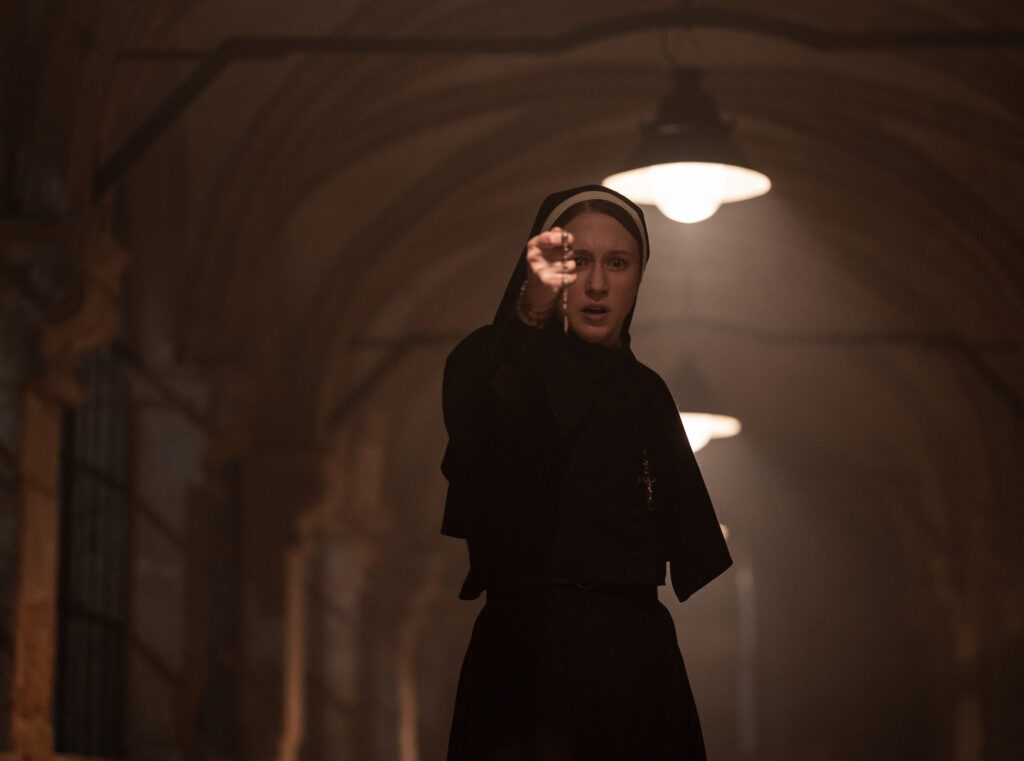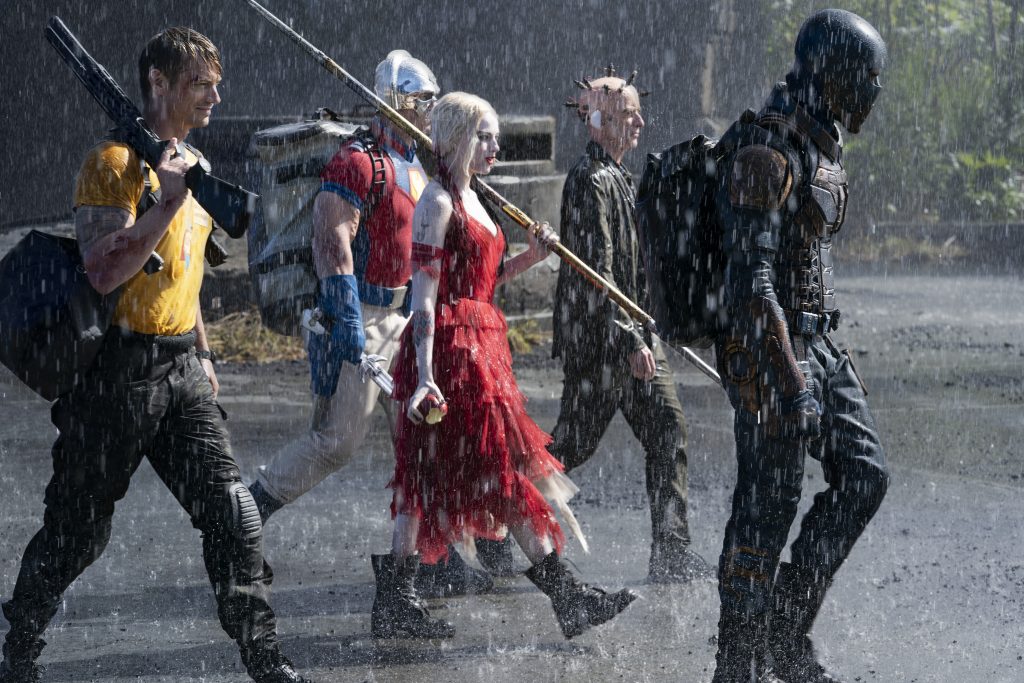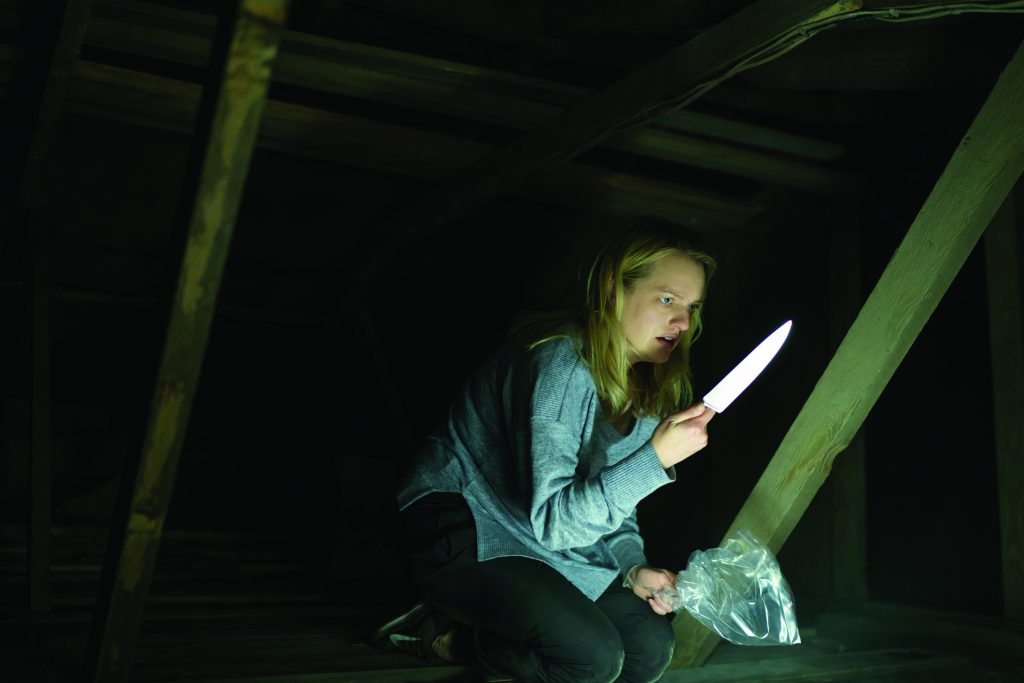September 7, 2023
by Carla Hay

Directed by Michael Chaves
Some language in French with subtitles
Culture Representation: Taking place in 1956, in France and briefly in Italy, the horror film “The Nun II” features a nearly all-white cast of characters (with one African American) representing the working-class and middle-class.
Culture Clash: Catholic nun Sister Irene teams up with novitiate Sister Debra to battle demon nun Valak at an all-girls’ boarding school in France.
Culture Audience: “The Nun II” will appeal primarily to people who are fans of “The Nun” movie and other films in “The Conjuring” Universe, but this substandard sequel has a muddled, stereotypical plot that doesn’t do anything interesting or clever.

“The Nun II” puts a lot of effort into setting up dark and foreboding scenes, but it’s all style over substance. This lazy sequel just churns out weak jump scares and tiresome horror clichés about demons and Catholicism. The story has very little suspense. The 2018 horror film “The Nun” was a big hit, even though that movie’s story was also plagued by the same problems of being witless and very formulaic. “The Nun” movies are part of “The Conjuring” horror movie universe that began with 2013’s “The Conjuring.”
Directed by Michael Chaves, “The Nun II” has some of the same filmmakers on board who were also responsible for “The Nun,” including producers Peter Safran and James Wan. But “The Nun II” has an almost entirely different cast and crew from “The Nun.” Ian Goldberg, Richard Naing and Akela Cooper co-wrote “The Nun II” screenplay.
“The Nun II” takes place in 1956 in France—four years after the events of “The Nun,” which took place in Romania. (“The Nun II” was filmed on location in France.) Taissa Farmiga reprises her role as an American named Sister Irene, an earnest and kind-hearted Catholic nun who finds herself once again trying to defeat a demon nun called Valak (played by Bonnie Aarons), who is capable of possessing human beings.
“The Nun II” begins with a scene in Tarascon, France, where inside a nearly empty Catholic church (which is very dark on the inside, because this is a horror movie), a boy of about 9 or 10 years old named Jacques (played by Maxime Elias-Menet) is doing some chores when he notices that a ball that’s the size of a soccer ball keeps mysteriously moving on its own on the floor. It isn’t long before Valak appears. The only other person in the church is a priest named Father Noiret (played by Pascal Aubert), who meets a horrific fate of being engulfed in flames, which is witnessed by Jacques. News of this tragedy reaches the Vatican.
Meanwhile, in Aix-en-Provence, France, a handyman named Maurice (played by Jonas Bloquet) arrives at new job at St. Mary’s Boarding School for Girls, which used to be a convent years ago. Maurice interacts with the students in a friendly and sometimes protective manner. The girls, who seem to be mostly from the United Kingdom and France, appear to be between the ages of 12 to 14. One of the students, whose name is Sophie (played by Katelyn Rose Downey) is the target of “mean girl” bullies, led by a snobby brat named Simone (played by Léontine d’Oncieu), who puts Sophie in increasing danger as the story goes on.
Maurice likes to look out for Sophie, almost like a father figure. That’s because Maurice acts like he could become Sophie’s stepfather. Maurice is very attracted to Sophie’s single mother Kate (played by Anna Popplewell), who is a teacher at the school. Kate is attracted to Maurice too, but she is much more reserved about expressing her feelings than he is. The details of what happened to Sophie’s biological father are not discussed, but it’s implied that the relationship ended badly and caused a lot of pain to Kate.
Kate being an authority figure at the school doesn’t stop Simone from bullying Sophie. In a scene where Maurice tells Simone to treat everyone with kindness and respect, Simone haughtily tells Maurice why she thinks she doesn’t have to listen to him: “You’re not a teacher. You’re a servant.” And when you have a mean-spirited kid in a horror movie, you know what’s going to eventually happen to that troublemaker when there’s a demon on the loose.
People who saw “The Nun” might notice immediately that Maurice is really someone named Frenchie, a character who lived in the same Romanian village were Valak appeared in “The Nun.” Viewers who remember what happened to Frenchie in “The Nun” (spoiler alert: he was possessed by Valak) will not be surprised when they see Frenchie/Maurice acting strangely while he’s working on the boarding school campus. People at the school, including Sophie, see that Maurice often stands still and stares upward, as if he’s in a trance. Valak strikes again, and a local boy is killed.
And it isn’t long before Sister Irene is asked by an official named Cardinal Conroy (played by David Horovitch) to investigate if there’s a possible demon in Aix-en-Provence, France. The Vatican knows that Sister Irene has a reputation for being good at defeating demons in semi-secretive missions, based on that happened in “The Nun.” Sister Irene is very reluctant to take on this task at first, but she eventually agrees. This time, she’ll have another young nun as her sidekick: Sister Irene has recently become acquainted with a 21-year-old novitiate named Sister Debra (played by Storm Reid), who somehow gets clearance to go on this demon-hunting mission too.
Before the two nuns leave for France, there’s a scene where Sister Debra and Sister Irene briefly talk about their sob story backgrounds to each other. Sister Irene says her mother died when she was young. Sister Irene was despised by her father, who sent her away for being “different” and because he said that Irene was too much like her mother. In this movie, Sister Irene is the “good” nun, while Sister Debra (who is first seen smoking a cigarette) is the “rebellious” nun.
Sister Debra, who African American and originally from Mississippi, says she was also sent away by her father, for different reasons. Their family home was burned down by racists. Sister Debra’s mother died in the fire. Sister Debra’s father then sent his children away because he thought they would be safer if they lived elsewhere. Sister Debra’s brothers were sent away to join the military, while Sister Debra was sent away to become a nun.
At one point, Sister Debra hears the story of the nuns at an abbey in St. Carta (in Romania), where all the nuns were killed, except for one who managed to escape. Of course, Sister Irene knows what happened, but she doesn’t tell Sister Debra right away. Another story is told later about St. Lucy, whose eyes were removed. The two stories are connected to the reason why Valak is on this rampage. The so-called mystery is so easy to figure out, viewers would have to be not paying attention to miss all the obvious clues.
And it would be understandable if viewers stop paying attention while watching “The Nun II.” It’s one of those boring horror movies with characters and scenarios that are so poorly written and unremarkable, a viewer’s mind could easily start to wander while watching this underwhelming slog that is just a series of many scenes that have been done in one way or another (and much better) in several other horror films. All of the scenes where characters are chased or attacked look too fake to be truly horrifying.
Even the movie’s most visually memorable scene turns out to be a dud. In this scene, Sister Irene is alone on a dark and deserted street at night. At a magazine stand that somehow is the only thing on this street with decent lighting, a mysterious force appears to be opening the magazines and flipping pages, until the all the open pages form a mosaic-like image of Valak.
What happens next is just another scene in “The Nun II” that seems like it’s going to be truly terrifying, but then it literally falls flat. (Mild spoiler alert: In this scene, Valak attacks Sister Irene, who is then found unconscious by Sister Debra.) Considering what viewers find out later about Valak’s main motive to kill, the way this scene ends makes absolutely no sense. The production design of this scene also looks phony. It looks more like a movie set than a real street.
“The Nun II” is filled with a lot of scenes that are just thrown in the movie just to show more horror set-ups with not much payoff. There’s a minor subplot about the boarding school’s stern headmistress Madame Laurent (played by Suzanne Bertish), who is still grieving over the death of her underage son Cedric (played by Gaël Raës), who was killed in bombings during World War I. Cedric also used to be an altar boy. As soon as Cedric is mentioned in the movie, you just know what kind of scene will happen when “the ghost of Cedric” makes an appearance.
All of the acting performances are serviceable, but they are hampered by a dreadfully formulaic screenplay that jumps around from one flimsy horror trope to the next. The film editing for the action scenes is very sloppy. A mid-credits scene in “The Nun II” is a knockoff of the last scene in “The Nun.” “The Nun” got a lot of criticism for being dull and often stupid. It seems like the makers of “The Nun II” didn’t care to offer many improvements for this sequel, and they just dumped out a story that wallows in the mush of mediocrity.
Warner Bros. Pictures will release “The Nun II” in U.S. cinemas on September 8, 2023.






